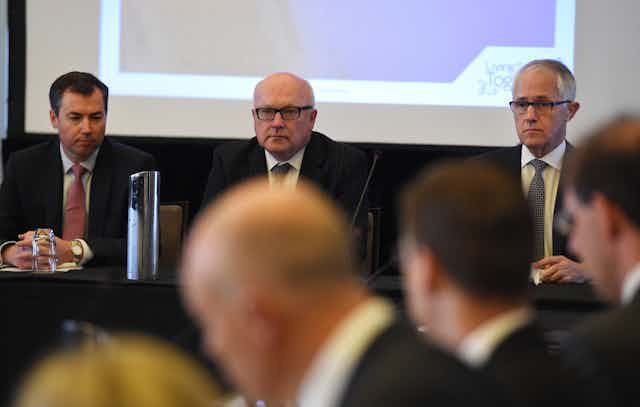Attorney-General George Brandis has flagged that, in a fifth tranche of counter-terrorism laws to be introduced to parliament in the coming weeks, the government will lower the age at which a control order can be applied from 16 to 14 years of age.
Since Brandis’ initial announcement, Justice Minister Michael Keenan has said the government is open to extending control orders to children as young as 12. But whether lowering the age at which a person can be subject to a control order to 14 – or even 12 – will make Australia safer is less than clear.
What are control orders?
Control orders are civil measures that impose obligations and restrictions on an individual. A court can issue a control order only if it will substantially help prevent a terrorist attack, or if the person against whom an order is being made has trained or participated in training with a listed terrorist organisation, engaged in a hostile activity in a foreign country, or been convicted of a terrorism-related offence.
The types of controls that can be imposed include:
electronic tagging;
curfews;
requirements to report to police; and
restrictions on attending certain places, associating with certain people and using electronic means of communication.
Control orders were first introduced into Australia in December 2005 in response to the suicide bombings in London earlier that year. They were modelled on the UK’s system. The regime was significantly expanded in 2014 as part of amendments to Australia’s anti-terror laws to meet the threat posed by foreign fighters.
Though upheld as constitutionally valid in 2007, the control order regime has faced significant criticism. Former Independent National Security Legislation Monitor Bret Walker, SC, is sceptical of control orders – not only of the recent proposal to lower the age at which a person can be subject to a control order, but of the regime’s general efficacy. He said he was:
… sure that the notion of control orders for 14-year-olds is no more tested than control orders, really, for anyone. There’s simply no experience from which one could sensibly say, “This is going to make us safer.”
In his 2012 annual report Walker reviewed the operation, effectiveness and implications of the control order regime. He recommended abolishing the system in its entirety. In doing so he reviewed the two control orders that had at that time been issued, as well as every occasion on which the Australian Federal Police had considered applying for a control order.
Walker was particularly concerned about the possible use of control orders as an alternative in cases where there was insufficient evidence to mount a prosecution.
Since Walker’s report was tabled in May 2013, a further four control orders have been issued. The first two, issued in December 2014, are subject to non-publication orders. Little is known about them.
In March 2015, a control order was issued against Ahmad Nazimand, a 20-year-old arrested and released without charge following the September 2014 Sydney raids. He is reportedly connected to the recent Parramatta shooting, in which a 15-year-old boy shot dead a civilian police employee.
The final control order was issued against Harun Causevic in the situation Walker warned against.
The Causevic case
In August, criminal charges were dropped against Causevic, an 18-year-old who had been arrested in April on suspicion of being part of the Anzac Day terrorist plot.
Despite the insufficient evidence with which to prosecute Causevic, the summary of grounds on which the interim control order was made said that:
Mr Causevic was involved in planning a terrorist act which was to occur on or around Anzac Day 2015 in Melbourne, but which was disrupted on 18 April 2015 by the arrest of Sevdet Besim … and the detention of Mr Causevic.
The ten controls imposed on Causevic will, according to the interim control order:
… protect the public and substantially assist in preventing a terrorist act.
This is likely to be true. Of the six control orders issued to date, only one person has been found to have breached their order. And no-one subject to a control order has been charged with terrorism-related offences.

Will it make Australia safer?
It is less than clear whether lowering the age at which a person can be subject to a control order to 14 will substantially reduce the threat that Australia faces. A control order is only useful where the police have sufficient intelligence about a person’s activity to apply for an order.
NSW Police Commissioner Andrew Scipione confirmed that they had no prior information that the Parramatta shooter, Farhad Khalil Mohammad Jabar, posed “this type of threat”. A control order therefore could not have prevented the attack – just as control orders did not prevent the London bombings.
Former NSW Supreme Court justice Anthony Whealy, who chaired the COAG review that recommended the retention of control orders with additional safeguards, said this week that:
Perhaps we should allow control orders against somebody who’s under 16, but, you know, control orders are not really the answer. They are simply a method of controlling or fettering someone’s activities.
Lowering the age at which a control order can be imposed to 14 must involve significant public consultation and parliamentary deliberation. The reactive and truncated parliamentary processes that have characterised much of Australia’s recent anti-terror lawmaking should not extend to the next tranche.
Independent National Security Legislation Monitor Roger Gyles, QC, is conducting an inquiry into the adequacy of the safeguards relating to the control order regime. His recommendations should be considered before implementing further changes to the system, particularly those that restrict the liberty of children.

